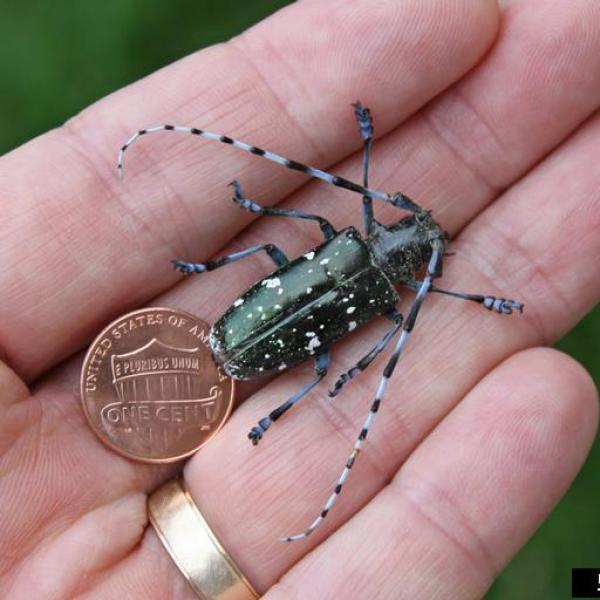
Washington, Aug. 3, 2015 — The U.S. Department of Agriculture's (USDA) Animal and Plant Health Inspection Service (APHIS) announces August is Tree Check Month and urges people to check trees for signs of the invasive Asian longhorned beetle (ALB). August is a time of peak emergence for the beetle and is most likely when the adult beetle can be seen infesting trees.
“We are asking people to take 10 minutes to look at their trees for any damage caused by the Asian longhorned beetle and to look for the beetle itself, then let us know if you see something suspicious,” said Josie Ryan, APHIS’ national operations manager for the Asian Longhorned Beetle Eradication Program.
One of the most important ways people can help stop the beetle is to look for it and report it. A quick tree check in your yard or neighborhood could help spot the signs of the beetle early enough to prevent it from spreading further.
The beetle is a distinctive-looking insect with unique characteristics:
• body is about 1 inch to an inch and a half in length
• long antennae banded in black and white, which are longer than the insect’s body
• shiny jet black colored body with distinctive random white spots
• 6 legs and may have bluish colored feet
Signs of an ALB infestation start to show about 3 to 4 years after infestation:
• dime-sized, or smaller, perfectly round exit holes in the tree trunk or branches.
• shallow oval or round scars in the bark, where the adult beetle has chewed an egg site
• sawdust-like materials, called frass, on the ground around the tree or on the branches.
• dead branches or limbs falling from an otherwise healthy looking tree.
If you see something suspicious, please record the area where you found the insect or damage. If possible, capture the insect you think is an ALB, place it in a container and freeze it. Doing this will preserve the insect for easy identification. It is also a good idea to take digital pictures of the insect and/or tree damage. If you see a beetle or suspect that tree damage is caused by the ALB, please report it by calling 1-866-702-9938 or by filling out the online form available at http://asianlonghornedbeetle.com/report-your-findings/.
Since its discovery in the U.S. in 1996, the ALB has led to the loss over 130,000 trees. The insect has no known natural predators in the U.S. It bores through the tissues that carry water and nutrients throughout the tree, starving and weakening the tree until it dies. Early detection is important in stopping the spread of the ALB because once it infests a tree, that tree must be removed.The beetle threatens urban and suburban shade trees, recreational resources such as parks, forest resources and wildlife. It could also impact industries such as maple syrup production, hardwood lumber processing, nurseries, and tourism.
APHIS cooperates with State and local governments and residents of affected areas to find and destroy ALB infestations. APHIS and its cooperators have eradicated infestations in Illinois; New Jersey; Manhattan, Staten Island, and Islip, NY; and Boston, MA. Eradication efforts continue in Brooklyn and Queens, NY; on central Long Island, NY; in Worcester County, MA; and in Clermont County, OH. For ALB eradication efforts to be successful, residents in infested and non-infested areas must remain vigilant about this destructive pest. The sooner an infestation is reported, the sooner efforts can be made to quickly contain and isolate an area in order to prevent future destruction.
For more information about the Asian longhorned beetle and eradication program activities, please visit www.aphis.usda.gov or www.AsianLonghornedBeetle.com or call 1-866-702-9938 to be forwarded to your State Plant Health Director’s office.